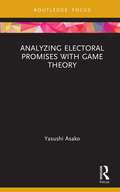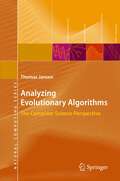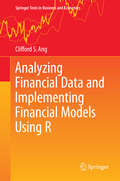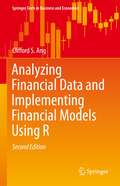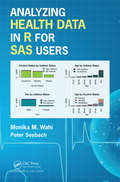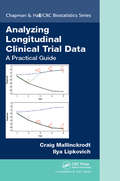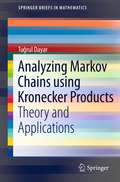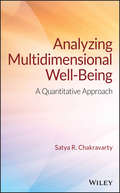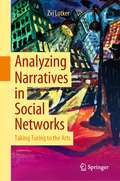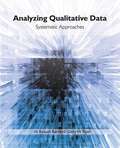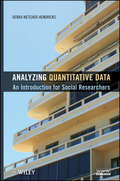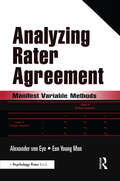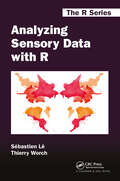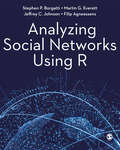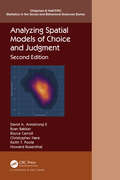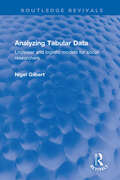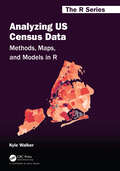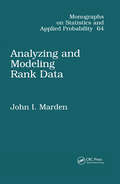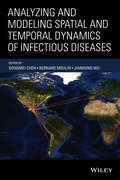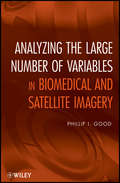- Table View
- List View
Analyzing Electoral Promises with Game Theory (Routledge Focus on Economics and Finance)
by Yasushi AsakoElectoral promises help to win votes and political candidates, or parties should strategically choose what they can deliver to win an election. Past game-theoretical studies tend to ignore electoral promises and this book sheds illuminating light on the functions and effects of electoral promises on policies or electoral outcomes through game theory models. This book provides a basic framework for game-theoretical analysis of electoral promises. The book also includes cases to illustrate real life applications of these theories.
Analyzing Evolutionary Algorithms: The Computer Science Perspective (Natural Computing Series)
by Thomas JansenEvolutionary algorithms is a class of randomized heuristics inspired by natural evolution. They are applied in many different contexts, in particular in optimization, and analysis of such algorithms has seen tremendous advances in recent years. In this book the author provides an introduction to the methods used to analyze evolutionary algorithms and other randomized search heuristics. He starts with an algorithmic and modular perspective and gives guidelines for the design of evolutionary algorithms. He then places the approach in the broader research context with a chapter on theoretical perspectives. By adopting a complexity-theoretical perspective, he derives general limitations for black-box optimization, yielding lower bounds on the performance of evolutionary algorithms, and then develops general methods for deriving upper and lower bounds step by step. This main part is followed by a chapter covering practical applications of these methods. The notational and mathematical basics are covered in an appendix, the results presented are derived in detail, and each chapter ends with detailed comments and pointers to further reading. So the book is a useful reference for both graduate students and researchers engaged with the theoretical analysis of such algorithms.
Analyzing Financial Data and Implementing Financial Models Using R (Springer Texts in Business and Economics)
by Clifford S. AngThis book is a comprehensive introduction to financial modeling that teaches advanced undergraduate and graduate students in finance and economics how to use R to analyze financial data and implement financial models. This text will show students how to obtain publicly available data, manipulate such data, implement the models, and generate typical output expected for a particular analysis. This text aims to overcome several common obstacles in teaching financial modeling. First, most texts do not provide students with enough information to allow them to implement models from start to finish. In this book, we walk through each step in relatively more detail and show intermediate R output to help students make sure they are implementing the analyses correctly. Second, most books deal with sanitized or clean data that have been organized to suit a particular analysis. Consequently, many students do not know how to deal with real-world data or know how to apply simple data manipulation techniques to get the real-world data into a usable form. This book will expose students to the notion of data checking and make them aware of problems that exist when using real-world data. Third, most classes or texts use expensive commercial software or toolboxes. In this text, we use R to analyze financial data and implement models. R and the accompanying packages used in the text are freely available; therefore, any code or models we implement do not require any additional expenditure on the part of the student. Demonstrating rigorous techniques applied to real-world data, this text covers a wide spectrum of timely and practical issues in financial modeling, including return and risk measurement, portfolio management, options pricing, and fixed income analysis.
Analyzing Financial Data and Implementing Financial Models Using R (Springer Texts in Business and Economics)
by Clifford S. AngThis advanced undergraduate/graduate textbook teaches students in finance and economics how to use R to analyse financial data and implement financial models. It demonstrates how to take publically available data and manipulate, implement models and generate outputs typical for particular analyses. A wide spectrum of timely and practical issues in financial modelling are covered including return and risk measurement, portfolio management, option pricing and fixed income analysis. This new edition updates and expands upon the existing material providing updated examples and new chapters on equities, simulation and trading strategies, including machine learnings techniques. Select data sets are available online.
Analyzing Health Data in R for SAS Users
by Monika Maya Wahi Peter SeebachAnalyzing Health Data in R for SAS Users is aimed at helping health data analysts who use SAS accomplish some of the same tasks in R. It is targeted to public health students and professionals who have a background in biostatistics and SAS software, but are new to R. For professors, it is useful as a textbook for a descriptive or regression modeling class, as it uses a publicly-available dataset for examples, and provides exercises at the end of each chapter. For students and public health professionals, not only is it a gentle introduction to R, but it can serve as a guide to developing the results for a research report using R software. Features: Gives examples in both SAS and R Demonstrates descriptive statistics as well as linear and logistic regression Provides exercise questions and answers at the end of each chapter Uses examples from the publicly available dataset, Behavioral Risk Factor Surveillance System (BRFSS) 2014 data Guides the reader on producing a health analysis that could be published as a research report Gives an example of hypothesis-driven data analysis Provides examples of plots with a color insert
Analyzing Linguistic Data
by R. H. BaayenStatistical analysis is a useful skill for linguists and psycholinguists, allowing them to understand the quantitative structure of their data. This textbook provides a straightforward introduction to the statistical analysis of language. Designed for linguists with a non-mathematical background, it clearly introduces the basic principles and methods of statistical analysis, using 'R', the leading computational statistics programme. The reader is guided step-by-step through a range of real data sets, allowing them to analyse acoustic data, construct grammatical trees for a variety of languages, quantify register variation in corpus linguistics, and measure experimental data using state-of-the-art models. The visualization of data plays a key role, both in the initial stages of data exploration and later on when the reader is encouraged to criticize various models. Containing over 40 exercises with model answers, this book will be welcomed by all linguists wishing to learn more about working with and presenting quantitative data.
Analyzing Longitudinal Clinical Trial Data: A Practical Guide (Chapman & Hall/CRC Biostatistics Series)
by Craig Mallinckrodt Ilya LipkovichAnalyzing Longitudinal Clinical Trial Data: A Practical Guide provides practical and easy to implement approaches for bringing the latest theory on analysis of longitudinal clinical trial data into routine practice.The book, with its example-oriented approach that includes numerous SAS and R code fragments, is an essential resource for statisticians and graduate students specializing in medical research. The authors provide clear descriptions of the relevant statistical theory and illustrate practical considerations for modeling longitudinal data. Topics covered include choice of endpoint and statistical test; modeling means and the correlations between repeated measurements; accounting for covariates; modeling categorical data; model verification; methods for incomplete (missing) data that includes the latest developments in sensitivity analyses, along with approaches for and issues in choosing estimands; and means for preventing missing data. Each chapter stands alone in its coverage of a topic. The concluding chapters provide detailed advice on how to integrate these independent topics into an over-arching study development process and statistical analysis plan.
Analyzing Markov Chains using Kronecker Products: Theory and Applications (SpringerBriefs in Mathematics)
by Tugrul DayarKronecker products are used to define the underlying Markov chain (MC) in various modeling formalisms, including compositional Markovian models, hierarchical Markovian models, and stochastic process algebras. The motivation behind using a Kronecker structured representation rather than a flat one is to alleviate the storage requirements associated with the MC. With this approach, systems that are an order of magnitude larger can be analyzed on the same platform. The developments in the solution of such MCs are reviewed from an algebraic point of view and possible areas for further research are indicated with an emphasis on preprocessing using reordering, grouping, and lumping and numerical analysis using block iterative, preconditioned projection, multilevel, decompositional, and matrix analytic methods. Case studies from closed queueing networks and stochastic chemical kinetics are provided to motivate decompositional and matrix analytic methods, respectively.
Analyzing Multidimensional Well-Being: A Quantitative Approach
by Satya R. Chakravarty“An indispensable reference for all researchers interested in the measurement of social welfare. . .” —François Bourguignon, Emeritus Professor at Paris School of Economics, Former Chief Economist of the World Bank. “. . .a detailed, insightful, and pedagogical presentation of the theoretical grounds of multidimensional well-being, inequality, and poverty measurement. Any student, researcher, and practitioner interested in the multidimensional approach should begin their journey into such a fascinating theme with this wonderful book.” —François Maniquet, Professor, Catholic University of Louvain, Belgium. A Review of the Multidimensional Approaches to the Measurement of Welfare, Inequality, and Poverty Analyzing Multidimensional Well-Being: A Quantitative Approach offers a comprehensive approach to the measurement of well-being that includes characteristics such as income, health, literacy, and housing. The author presents a systematic comparison of the alternative approaches to the measurement of multidimensional welfare, inequality, poverty, and vulnerability. The text contains real-life applications of some multidimensional aggregations (most of which have been designed by international organizations such as the United Nations Development Program and the Organization for Economic Co-operation and Development) that help to judge the performance of a country in the various dimensions of well-being. The text offers an evaluation of how well a society is doing with respect to achievements of all the individuals in the dimensions considered and clearly investigates how achievements in the dimensions can be evaluated from different perspectives. The author includes a detailed scrutiny of alternative techniques for setting weights to individual dimensional metrics and offers an extensive analysis into both the descriptive and welfare theoretical approaches to the concerned multi-attribute measurement and related issues. This important resource: • Contains a synthesis of multidimensional welfare, inequality, poverty, and vulnerability analysis • Examines aggregations of achievement levels in the concerned dimensions of well-being from various standpoints • Shows how to measure poverty using panel data instead of restricting attention to a single period and when we have imprecise information on dimensional achievements • Argues that multidimensional analysis is intrinsically different from marginal distributions-based analysis Written for students, teachers, researchers, and scholars, Analyzing Multidimensional Well-Being: A Quantitative Approach puts the focus on various approaches to the measurementof the many aspects of well-being and quality of life. Satya R. Chakravarty is a Professor of Economics at the Indian Statistical Institute, Kolkata, India. He is an Editor of Social Choice and Welfare and a member of the Editorial Board of Journal of Economic Inequality.
Analyzing Narratives in Social Networks: Taking Turing to the Arts
by Zvi LotkerThis book uses literature as a wrench to pry open social networks and to ask different questions than have been asked about social networks previously. The book emphasizes the story-telling aspect of social networks, as well as the connection between narrative and social networks by incorporating narrative, dynamic networks, and time. Thus, it constructs a bridge between literature, digital humanities, and social networks. This book is a pioneering work that attempts to express social and philosophic constructs in mathematical terms.The material used to test the algorithms is texts intended for performance, such as plays, film scripts, and radio plays; mathematical representations of the texts, or “literature networks”, are then used to analyze the social networks found in the respective texts. By using literature networks and their accompanying narratives, along with their supporting analyses, this book allows for a novel approach to social network analysis.
Analyzing Qualitative Data: Systematic Approaches
by Gery Ryan H. BernardThis book introduces readers to systematic methods for analyzing qualitative data. Unlike other texts, it covers the extensive range of available methods so that readers become aware of the array of techniques beyond their individual disciplines. Part I is an overview of the basics. Part II comprises 11 chapters, each treating a different method for analyzing text. Real examples from the literature across the health and social sciences provide invaluable applied understanding.
Analyzing Quantitative Data
by Debra Wetcher-HendricksA user-friendly, hands-on guide to recognizing and conducting proper research techniques in data collection Offering a unique approach to numerical research methods, Analyzing Quantitative Data: An Introduction for Social Researchers presents readers with the necessary statistical applications for carrying out the key phases of conducting and evaluating a research project. The book guides readers through the steps of data analysis, from organizing raw data to utilizing descriptive statistics and tests of significance, drawing valid conclusions, and writing research reports. The author successfully provides a presentation that is accessible and hands-on rather than heavily theoretical, outlining the key quantitative processes and the use of software to successfully draw valid conclusions from gathered data. In its discussion of methods for organizing data, the book includes suggestions for coding and entry into spreadsheets or databases while also introducing commonly used descriptive statistics and clarifying their roles in data analysis. Next, inferential statistics is explored in-depth with explanations of and instructions for performing chi-square tests, t-tests, analyses of variance, correlation and regression analyses, and a number of advanced statistical procedures. Each chapter contains explanations of when to use the tests described, relevant formulas, and sample computations. The book concludes with guidance on extracting meaningful conclusions from statistical tests and writing research reports that describe procedures and analyses. Throughout the book, Statistical Resources for SPSS® sections provide fundamental instruction for using SPSS® to obtain the results presented. Where necessary, the author provides basic theoretical explanations for distributions and background information regarding formulas. Each chapter concludes with practice problems, and a related website features derivations of the book's formulas along with additional resources for performing the discussed processes. Analyzing Quantitative Data is an excellent book for social sciences courses on data analysis and research methods at the upper-undergraduate and graduate levels. It also serves as a valuable reference for applied statisticians and practitioners working in the fields of education, medicine, business and public service who analyze, interpret, and evaluate data in their daily work.
Analyzing Rater Agreement: Manifest Variable Methods
by Alexander von Eye Eun Young MunAgreement among raters is of great importance in many domains. For example, in medicine, diagnoses are often provided by more than one doctor to make sure the proposed treatment is optimal. In criminal trials, sentencing depends, among other things, on the complete agreement among the jurors. In observational studies, researchers increase reliability by examining discrepant ratings. This book is intended to help researchers statistically examine rater agreement by reviewing four different approaches to the technique.The first approach introduces readers to calculating coefficients that allow one to summarize agreements in a single score. The second approach involves estimating log-linear models that allow one to test specific hypotheses about the structure of a cross-classification of two or more raters' judgments. The third approach explores cross-classifications or raters' agreement for indicators of agreement or disagreement, and for indicators of such characteristics as trends. The fourth approach compares the correlation or covariation structures of variables that raters use to describe objects, behaviors, or individuals. These structures can be compared for two or more raters. All of these methods operate at the level of observed variables.This book is intended as a reference for researchers and practitioners who describe and evaluate objects and behavior in a number of fields, including the social and behavioral sciences, statistics, medicine, business, and education. It also serves as a useful text for graduate-level methods or assessment classes found in departments of psychology, education, epidemiology, biostatistics, public health, communication, advertising and marketing, and sociology. Exposure to regression analysis and log-linear modeling is helpful.
Analyzing Sensory Data with R (Chapman & Hall/CRC The R Series)
by Sebastien Le Thierry Worch Margot BrardChoose the Proper Statistical Method for Your Sensory Data Issue Analyzing Sensory Data with R gives you the foundation to analyze and interpret sensory data. The book helps you find the most appropriate statistical method to tackle your sensory data issue. Covering quantitative, qualitative, and affective approaches, the book presents the big picture of sensory evaluation. Through an integrated approach that connects the different dimensions of sensory evaluation, you’ll understand: The reasons why sensory data are collected The ways in which the data are collected and analyzed The intrinsic meaning of the data The interpretation of the data analysis results Each chapter corresponds to one main sensory topic. The chapters start with presenting the nature of the sensory evaluation and its objectives, the sensory particularities related to the sensory evaluation, details about the data set obtained, and the statistical analyses required. Using real examples, the authors then illustrate step by step how the analyses are performed in R. The chapters conclude with variants and extensions of the methods that are related to the sensory task itself, the statistical methodology, or both.
Analyzing Social Networks Using R
by Jeffrey C. Johnson Martin G. Everett Stephen P. Borgatti Filip AgneessensThis approachable book introduces network research in R, walking you through every step of doing social network analysis. Drawing together research design, data collection and data analysis, it explains the core concepts of network analysis in a non-technical way. The book balances an easy to follow explanation of the theoretical and statistical foundations underpinning network analysis with practical guidance on key steps like data management, preparation and visualisation. With clarity and expert insight, it: • Discusses measures and techniques for analyzing social network data, including digital media • Explains a range of statistical models including QAP and ERGM, giving you the tools to approach different types of networks • Offers digital resources like practice datasets and worked examples that help you get to grips with R software
Analyzing Social Networks Using R
by Jeffrey C. Johnson Martin G. Everett Stephen P. Borgatti Filip AgneessensThis approachable book introduces network research in R, walking you through every step of doing social network analysis. Drawing together research design, data collection and data analysis, it explains the core concepts of network analysis in a non-technical way. The book balances an easy to follow explanation of the theoretical and statistical foundations underpinning network analysis with practical guidance on key steps like data management, preparation and visualisation. With clarity and expert insight, it: • Discusses measures and techniques for analyzing social network data, including digital media • Explains a range of statistical models including QAP and ERGM, giving you the tools to approach different types of networks • Offers digital resources like practice datasets and worked examples that help you get to grips with R software
Analyzing Spatial Models of Choice and Judgment (Chapman & Hall/CRC Statistics in the Social and Behavioral Sciences #14)
by Keith T. Poole Howard Rosenthal Ryan Bakker Royce Carroll Christopher Hare David A. ArmstrongWith recent advances in computing power and the widespread availability of preference, perception and choice data, such as public opinion surveys and legislative voting, the empirical estimation of spatial models using scaling and ideal point estimation methods has never been more accessible.The second edition of Analyzing Spatial Models of Choice and Judgment demonstrates how to estimate and interpret spatial models with a variety of methods using the open-source programming language R. Requiring only basic knowledge of R, the book enables social science researchers to apply the methods to their own data. Also suitable for experienced methodologists, it presents the latest methods for modeling the distances between points. The authors explain the basic theory behind empirical spatial models, then illustrate the estimation technique behind implementing each method, exploring the advantages and limitations while providing visualizations to understand the results. This second edition updates and expands the methods and software discussed in the first edition, including new coverage of methods for ordinal data and anchoring vignettes in surveys, as well as an entire chapter dedicated to Bayesian methods. The second edition is made easier to use by the inclusion of an R package, which provides all data and functions used in the book. David A. Armstrong II is Canada Research Chair in Political Methodology and Associate Professor of Political Science at Western University. His research interests include measurement, Democracy and state repressive action. Ryan Bakker is Reader in Comparative Politics at the University of Essex. His research interests include applied Bayesian modeling, measurement, Western European politics, and EU politics. Royce Carroll is Professor in Comparative Politics at the University of Essex. His research focuses on measurement of ideology and the comparative politics of legislatures and political parties. Christopher Hare is Assistant Professor in Political Science at the University of California, Davis. His research focuses on ideology and voting behavior in US politics, political polarization, and measurement. Keith T. Poole is Philip H. Alston Jr. Distinguished Professor of Political Science at the University of Georgia. His research interests include methodology, US political-economic history, economic growth and entrepreneurship. Howard Rosenthal is Professor of Politics at NYU and Roger Williams Straus Professor of Social Sciences, Emeritus, at Princeton. Rosenthal’s research focuses on political economy, American politics and methodology.
Analyzing Tabular Data: Loglinear and logistic models for social researchers (Routledge Revivals)
by Nigel GilbertFirst published in 1993, Analyzing Tabular Data is an accessible text introducing a powerful range of analytical methods. Empirical social research almost invariably requires the presentation and analysis of tables, and this book is for those who have little prior knowledge of quantitative analysis or statistics, but who have a practical need to extract the most from their data. The book begins with an introduction to the process of data analysis and the basic structure of cross-tabulations. At the core of the methods described in the text is the loglinear model. This and the logistic model, are explained and their application to causal modelling, to event history analysis, and to social mobility research are described in detail. Each chapter concludes with sample programs to show how analysis on typical datasets can be carried out using either the popular computer packages, SPSS, or the statistical programme, GLIM. The book is packed with examples which apply the methods to social science research. Sociologists, geographers, psychologists, economists, market researchers and those involved in survey research in the fields of planning, evaluation and policy will find the book to be a clear and thorough exposition of methods for the analysis of tabular data.
Analyzing US Census Data: Methods, Maps, and Models in R (Chapman & Hall/CRC The R Series)
by Kyle WalkerCensus data are widely used by practitioners to understand demographic change, allocate resources, address inequalities, and make sound business decisions. Until recently, projects using US Census data have required proficiency with multiple web interfaces and software platforms to prepare, map, and present data products. This book introduces readers to tools in the R programming language for accessing and analyzing Census data, helping analysts manage these types of projects in a single computing environment. Chapters in this book cover the following key topics: • Rapidly acquiring data from the decennial US Census and American Community Survey using R, then analyzing these datasets using tidyverse tools; • Visualizing US Census data with a wide range of methods including charts in ggplot2 as well as both static and interactive maps; • Using R as a geographic information system (GIS) to manage, analyze, and model spatial demographic data from the US Census; • Working with and modeling individual-level microdata from the American Community Survey’s PUMS datasets; • Applying these tools and workflows to the analysis of historical Census data, other US government datasets, and international Census data from countries like Canada, Brazil, Kenya, and Mexico. Kyle Walker is an associate professor of geography at Texas Christian University, director of TCU’s Center for Urban Studies, and a spatial data science consultant. His research focuses on demographic trends in the United States, demographic data visualization, and software tools for open spatial data science. He is the lead author of a number of R packages including tigris, tidycensus, and mapboxapi.
Analyzing and Modeling Rank Data (Chapman & Hall/CRC Monographs on Statistics and Applied Probability)
by John I MardenThis book is the first single source volume to fully address this prevalent practice in both its analytical and modeling aspects. The information discussed presents the use of data consisting of rankings in such diverse fields as psychology, animal science, educational testing, sociology, economics, and biology. This book systematically presents th
Analyzing and Modeling Spatial and Temporal Dynamics of Infectious Diseases
by Jianhong Wu Bernard Moulin Dongmei ChenFeatures modern research and methodology on the spread of infectious diseases and showcases a broad range of multi-disciplinary and state-of-the-art techniques on geo-simulation, geo-visualization, remote sensing, metapopulation modeling, cloud computing, and pattern analysisGiven the ongoing risk of infectious diseases worldwide, it is crucial to develop appropriate analysis methods, models, and tools to assess and predict the spread of disease and evaluate the risk. Analyzing and Modeling Spatial and Temporal Dynamics of Infectious Diseases features mathematical and spatial modeling approaches that integrate applications from various fields such as geo-computation and simulation, spatial analytics, mathematics, statistics, epidemiology, and health policy. In addition, the book captures the latest advances in the use of geographic information system (GIS), global positioning system (GPS), and other location-based technologies in the spatial and temporal study of infectious diseases.Highlighting the current practices and methodology via various infectious disease studies, Analyzing and Modeling Spatial and Temporal Dynamics of Infectious Diseases features:Approaches to better use infectious disease data collected from various sources for analysis and modeling purposesExamples of disease spreading dynamics, including West Nile virus, bird flu, Lyme disease, pandemic influenza (H1N1), and schistosomiasisModern techniques such as Smartphone use in spatio-temporal usage data, cloud computing-enabled cluster detection, and communicable disease geo-simulation based on human mobilityAn overview of different mathematical, statistical, spatial modeling, and geo-simulation techniquesAnalyzing and Modeling Spatial and Temporal Dynamics of Infectious Diseases is an excellent resource for researchers and scientists who use, manage, or analyze infectious disease data, need to learn various traditional and advanced analytical methods and modeling techniques, and become aware of different issues and challenges related to infectious disease modeling and simulation. The book is also a useful textbook and/or supplement for upper-undergraduate and graduate-level courses in bioinformatics, biostatistics, public health and policy, and epidemiology.
Analyzing the Large Number of Variables in Biomedical and Satellite Imagery
by Phillip I. GoodThis book grew out of an online interactive offered through statcourse.com, and it soon became apparent to the author that the course was too limited in terms of time and length in light of the broad backgrounds of the enrolled students. The statisticians who took the course needed to be brought up to speed both on the biological context as well as on the specialized statistical methods needed to handle large arrays. Biologists and physicians, even though fully knowledgeable concerning the procedures used to generate microaarrays, EEGs, or MRIs, needed a full introduction to the resampling methods--the bootstrap, decision trees, and permutation tests, before the specialized methods applicable to large arrays could be introduced. As the intended audience for this book consists both of statisticians and of medical and biological research workers as well as all those research workers who make use of satellite imagery including agronomists and meteorologists, the book provides a step-by-step approach to not only the specialized methods needed to analyze the data from microarrays and images, but also to the resampling methods, step-down multi-comparison procedures, multivariate analysis, as well as data collection and pre-processing. While many alternate techniques for analysis have been introduced in the past decade, the author has selected only those techniques for which software is available along with a list of the available links from which the software may be purchased or downloaded without charge. Topical coverage includes: very large arrays; permutation tests; applying permutation tests; gathering and preparing data for analysis; multiple tests; bootstrap; applying the bootstrap; classification methods; decision trees; and applying decision trees.
Anandadayak Ganit class 1 - NCERT - 23: आनन्ददायकं गणितम् कक्षा १ - एनसीईआरटी - २३
by National Council of Educational Research and Trainingइयत्ता पहिलीसाठी आनंददायी गणित या पाठ्यपुस्तकातील आशय NCF-FS 2022 मध्ये नमूद केलेल्या पुढील चार घटकांवर आधारित आहे तोंडी गणित चर्चा, कौशल्य शिकवणे, कौशल्य सराव आणि गणिती खेळ सर्व अध्यायांमध्ये समाविष्ट केले गेले आहेत. त्यापैकी बहुतेक एकात्मिक पद्धतीने सादर केले आहेत. तथापि, खालील प्रकरणे केवळ गणितीय समज आणि क्षमता विकसित करण्याच्या अभ्यासक्रमाच्या उद्दिष्टाशी (CG-8) आणि परिमाणे, आकार आणि मापे यांद्वारा जग ओळखू शकण्याशीच संरेखित नाहीत तर NCF-FS 2022 मध्ये दिलेल्या सर्वांगीण विकासाकडे नेणाऱ्या इतर सर्व अभ्यासक्रम व अभ्यासक्रमिय उद्दिष्टांशीदेखील सरेखित आहेत - मौखिक गणित चर्चा, कौशल्यशिक्षण, कौशल्यसराव आणि गणिती खेळ. बौद्धिक आव्हान आणि विचारप्रवर्तक कार्यांमुळे गणिताचे अध्ययन व निर्णयनक्षमता अधिक चांगल्या प्रकारे होते. मेंदूला सतावणारे प्रश्न, कोडी, कूट प्रश्न यामुळे नेहमीच्या शिकण्याच्या जोडीने मुलांना याची संधी मिळते. मुलांच्या वयाला साजेशी अनेक कोडी या पुस्तकात दिली आहेत.
Anandadayak Ganit class 2 - NCERT - 23: आनन्ददायकं गणितम् कक्षा २री - एनसीईआरटी - २३
by National Council of Educational Research and Trainingइयत्ता दुसरीसाठी असलेले आनंददायी गणित असे नाव असलेले गणिताचे पाठ्यपुस्तक NEP 2020, NCF-FS 2022 तसेच पायाभरणीच्या टप्प्यासाठीचा अभ्यासक्रम यांच्या शिफारसी डोळ्यासमोर ठेवून तयार केले आहे। बालवाटिका 1 ते 3 तसेच पहिली झाल्यावर (3-8 वर्षे वयात) दुसरीत जाणाऱ्या मुलाला अंकांचे ज्ञान झालेले असते, असे यात गृहीत धरले आहे। परंतु, आपल्या देशातील विविधता बघता, कदाचित काही मुलांची एकदम शाळेत पहिलीत गेल्यावरच पहिल्यांदा अंकांची ओळख होत असेल, असेही होऊ शकते। हे क्रमिक पुस्तक तयार करताना अशा परिस्थितीचाही विचार केलेला आहे। वयाच्या या टप्प्यावरील मुले मुक्तपणे खेळणे, खेळणी यात रमतात। हे लक्षात घेऊन, अवकाशीय समज, अंकहाताळणी, गणितीय आणि संगणकीय संकल्पना इ। शिकवण्यासाठीच्या उपक्रमांमध्ये खेळ, खेळणी यांचा वापर करण्यासाठी पुष्कळ वाव ठेवलेला आहे। यामुळे प्रत्येक नवीन संकल्पना किंवा कौशल्य शिकताना मूर्त वस्तूंकडून चित्रस्वरूपाकडे व त्याकडून अमूर्त कल्पनांपर्यंतचे संक्रमण सहजपणे होऊ शकते। सर्वांगीण विकासासाठी अनुभवातून शिक्षण हे उद्दिष्ट डोळ्यासमोर ठेवून, इयत्ता दुसरीसाठी असलेल्या आनंददायी गणित या पुस्तकामध्ये, वर्गात आणि वर्गाबाहेर करण्यासारखे अनेक उपक्रम दिले आहेत। यातील सर्व प्रकरणांमध्ये, उपक्रमाधारित कार्यांच्या माध्यमातून गणितीय संकल्पनांचे आकलन करून दिले आहे। सक्तीने, नाखुषीने गणित शिकण्याऐवजी, आपण खेळ खेळत आहोत अशा भावनेने मुलांनी हे उपक्रम करावेत आणि त्याद्वारे गणितीय संकल्पना आपोआप रुजाव्यात, अशा प्रकारचे वातावरण निर्माण करण्याचा प्रयत्न या पुस्तकातून केलेला आहे।
Anandadayi Ganit class 1 - NCERT - 23: आनंददायी गणित इयत्ता पहिली - एनसीईआरटी - २३
by National Council of Educational Research and Trainingइयत्ता पहिलीसाठी आनंददायी गणित या पाठ्यपुस्तकातील आशय NCF-FS 2022 मध्ये नमूद केलेल्या पुढील चार घटकांवर आधारित आहे तोंडी गणित चर्चा, कौशल्य शिकवणे, कौशल्य सराव आणि गणिती खेळ सर्व अध्यायांमध्ये समाविष्ट केले गेले आहेत. त्यापैकी बहुतेक एकात्मिक पद्धतीने सादर केले आहेत. तथापि, खालील प्रकरणे केवळ गणितीय समज आणि क्षमता विकसित करण्याच्या अभ्यासक्रमाच्या उद्दिष्टाशी (CG-8) आणि परिमाणे, आकार आणि मापे यांद्वारा जग ओळखू शकण्याशीच संरेखित नाहीत तर NCF-FS 2022 मध्ये दिलेल्या सर्वांगीण विकासाकडे नेणाऱ्या इतर सर्व अभ्यासक्रम व अभ्यासक्रमिय उद्दिष्टांशीदेखील सरेखित आहेत - मौखिक गणित चर्चा, कौशल्यशिक्षण, कौशल्यसराव आणि गणिती खेळ. बौद्धिक आव्हान आणि विचारप्रवर्तक कार्यांमुळे गणिताचे अध्ययन व निर्णयनक्षमता अधिक चांगल्या प्रकारे होते. मेंदूला सतावणारे प्रश्न, कोडी, कूट प्रश्न यामुळे नेहमीच्या शिकण्याच्या जोडीने मुलांना याची संधी मिळते. मुलांच्या वयाला साजेशी अनेक कोडी या पुस्तकात दिली आहेत.
